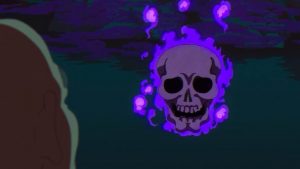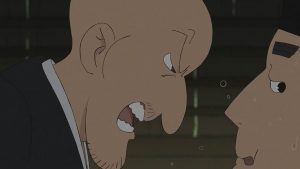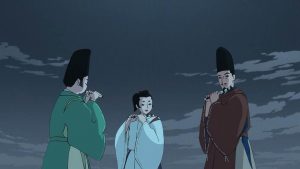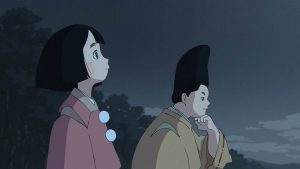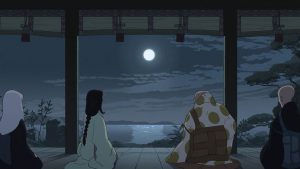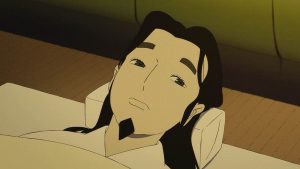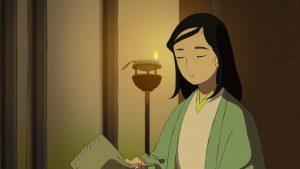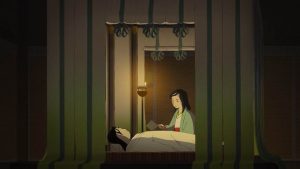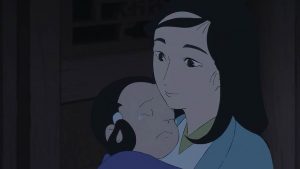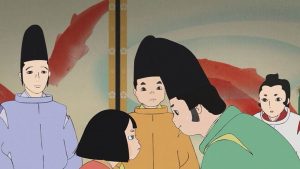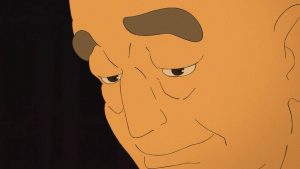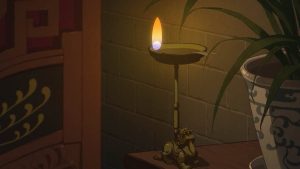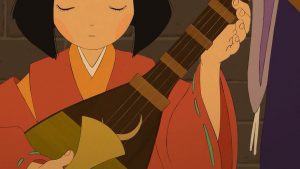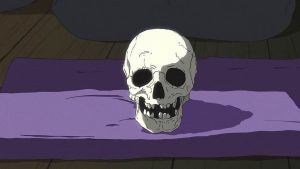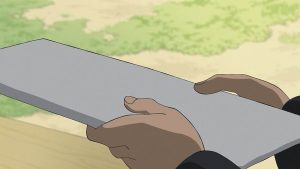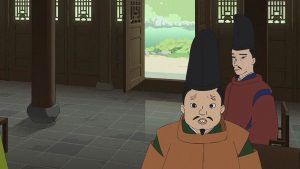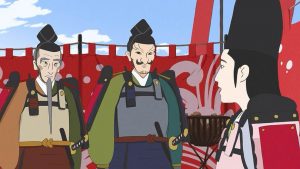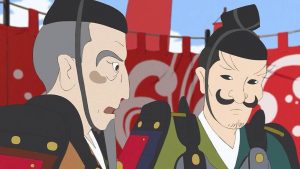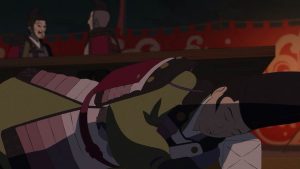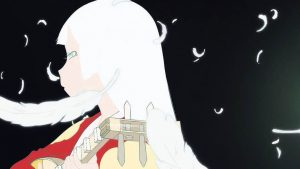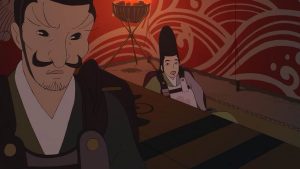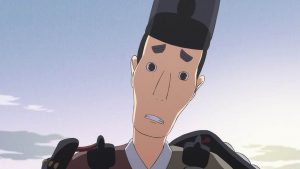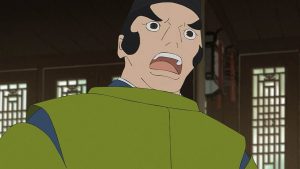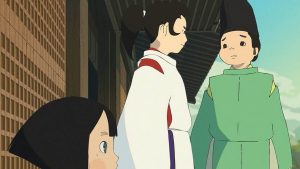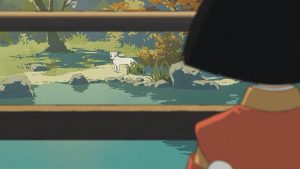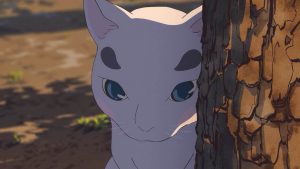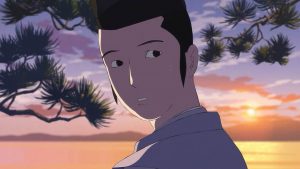 Well, that was certainly an improvement. If nothing else something of the pathos of this series can be salvaged if the narration slows down enough to give it a chance to express itself. That’s what happened this week, and it’s welcome. The only serious attempt to adapt Heike Monogatari to the screen, a 1970’s TV drama, took about fifty-two 45-minute episodes. We’re getting eleven 22-minute ones – the math isn’t too hard to figure out. Whatever else it may or not be, this is not a serious attempt at an adaptation.
Well, that was certainly an improvement. If nothing else something of the pathos of this series can be salvaged if the narration slows down enough to give it a chance to express itself. That’s what happened this week, and it’s welcome. The only serious attempt to adapt Heike Monogatari to the screen, a 1970’s TV drama, took about fifty-two 45-minute episodes. We’re getting eleven 22-minute ones – the math isn’t too hard to figure out. Whatever else it may or not be, this is not a serious attempt at an adaptation.
 When you’re using 10% of the screen time you’d need to adapt the material fully, you really only have two paths – plow through events at insane speed, or make massive cuts. This series has shown us something of both, but for me the latter option is probably the lesser of two evils. In point of fact I had some notion that Taira no Atsumori might be totally skipped as Ashika Tadatsuna was, as he his story doesn’t really fit the modernist take Science SARU have employed. This despite the fact that he was involved in perhaps the single most legendary incident of the entire Genpei War, at least as far as almost a millennium of Japanese culture is concerned.
When you’re using 10% of the screen time you’d need to adapt the material fully, you really only have two paths – plow through events at insane speed, or make massive cuts. This series has shown us something of both, but for me the latter option is probably the lesser of two evils. In point of fact I had some notion that Taira no Atsumori might be totally skipped as Ashika Tadatsuna was, as he his story doesn’t really fit the modernist take Science SARU have employed. This despite the fact that he was involved in perhaps the single most legendary incident of the entire Genpei War, at least as far as almost a millennium of Japanese culture is concerned.
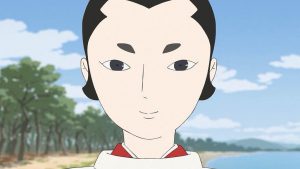 It now seems very likely that the anime is basically going to follow the span of Kiyomori’s life and end soon after, despite his only being a presence in the first major arc of the book. But Atsumori – subject of innumerable tanka, haiku, kabuki et al – was simply too massive a cultural figure to cut, I suppose. I won’t spoil his story for those of you that don’t know it, but here we see him mainly bonding with Shigemori’s children – especially Kiyotsune, the cousin Atsumori sees as something of a kindred spirit. They both love the flute too, and Atsumori is in possession of the legendary Saeda, a gift from the Emperor Toba to his grandfather Tadamori.
It now seems very likely that the anime is basically going to follow the span of Kiyomori’s life and end soon after, despite his only being a presence in the first major arc of the book. But Atsumori – subject of innumerable tanka, haiku, kabuki et al – was simply too massive a cultural figure to cut, I suppose. I won’t spoil his story for those of you that don’t know it, but here we see him mainly bonding with Shigemori’s children – especially Kiyotsune, the cousin Atsumori sees as something of a kindred spirit. They both love the flute too, and Atsumori is in possession of the legendary Saeda, a gift from the Emperor Toba to his grandfather Tadamori.
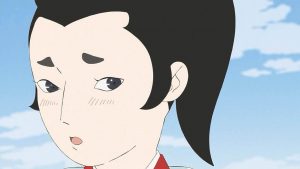 All this takes place in Fukuhara, known today as Kobe, where Kiyomori has been building his deep-water port. In an attempt to stem the smouldering fires of rebellion he moved the capital there in 1180. Because anyone staying in Kyoto would be considered rebellious against the Taira, most ripped their houses down board by board and trekked to Fukuhara-kyou, leaving the old capital a desolate wreck. Suffice to say there was no great rejoicing at this among the people, who loved their city and found Fukuhara a desolate backwater. This takes the tale into my old backyard, and in fact I visited some of the key Kobe locations from the book and wrote them up here (warning: spoilers).
All this takes place in Fukuhara, known today as Kobe, where Kiyomori has been building his deep-water port. In an attempt to stem the smouldering fires of rebellion he moved the capital there in 1180. Because anyone staying in Kyoto would be considered rebellious against the Taira, most ripped their houses down board by board and trekked to Fukuhara-kyou, leaving the old capital a desolate wreck. Suffice to say there was no great rejoicing at this among the people, who loved their city and found Fukuhara a desolate backwater. This takes the tale into my old backyard, and in fact I visited some of the key Kobe locations from the book and wrote them up here (warning: spoilers).
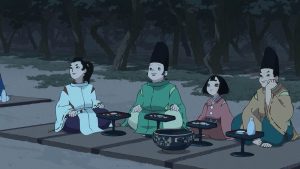 Meanwhile, the torch of rebellion has now fallen to Minamoto no Yoritomo, whose father was defeated by the Heike in the Heiji Rebellion. Kiyomori exiled Yoritomo and his two brothers, then small boys, acquiescing to pleas for lenience from his own stepmother. Yoritomo is shown here as having some remorse over turning on Kiyomori now because of this history, but the lure for him was simple – if he succeeded, he would be the most powerful man in Japan. And with the retired emperor Go-Shirakawa chafing under his confinement and ready to support him, the lure proved too great.
Meanwhile, the torch of rebellion has now fallen to Minamoto no Yoritomo, whose father was defeated by the Heike in the Heiji Rebellion. Kiyomori exiled Yoritomo and his two brothers, then small boys, acquiescing to pleas for lenience from his own stepmother. Yoritomo is shown here as having some remorse over turning on Kiyomori now because of this history, but the lure for him was simple – if he succeeded, he would be the most powerful man in Japan. And with the retired emperor Go-Shirakawa chafing under his confinement and ready to support him, the lure proved too great.
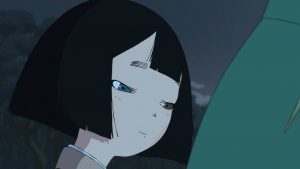 As Kiyomori battles visits by angry spirits, Yoritomo gathers the Genji and their retainers near Mt. Fuji. And his efforts are fruitful, as there are many simmering resentments against Heike authority – by the time the Taira confront him, Yoritomo has 200,000 men. Kiyomori sends Koremori at the head of his own army of 70,000, but Koremori is not a warrior and is ill-suited for the role. And it’s been a long time since the Heike have been involved in a real war – at the sheer size of the enemy facing them, the Taira forces panic and flee back to Fukuhara.
As Kiyomori battles visits by angry spirits, Yoritomo gathers the Genji and their retainers near Mt. Fuji. And his efforts are fruitful, as there are many simmering resentments against Heike authority – by the time the Taira confront him, Yoritomo has 200,000 men. Kiyomori sends Koremori at the head of his own army of 70,000, but Koremori is not a warrior and is ill-suited for the role. And it’s been a long time since the Heike have been involved in a real war – at the sheer size of the enemy facing them, the Taira forces panic and flee back to Fukuhara.
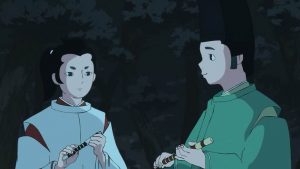 The scent of impending tragedy hangs heavy in the air here, and the massive cuts and tonal changes don’t manage to mask it. There are only five episodes left so the anime is going to have to skip an awful lot, but there are certain moments so integral to the Heike Monogatari that ignoring them for more Biwa simply isn’t an option. I’ll be fascinated to see what choices are made in this respect – what stays and what goes – but in a faithful adaptation this is where I would be saying the best of the story is very much yet to come.
The scent of impending tragedy hangs heavy in the air here, and the massive cuts and tonal changes don’t manage to mask it. There are only five episodes left so the anime is going to have to skip an awful lot, but there are certain moments so integral to the Heike Monogatari that ignoring them for more Biwa simply isn’t an option. I’ll be fascinated to see what choices are made in this respect – what stays and what goes – but in a faithful adaptation this is where I would be saying the best of the story is very much yet to come.




